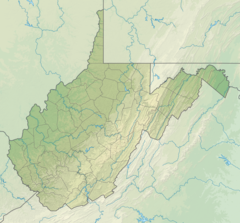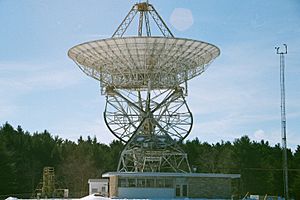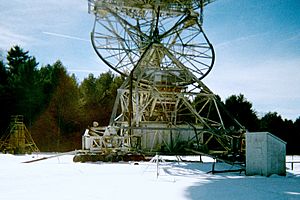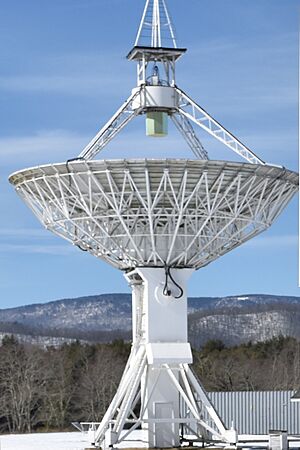Green Bank Interferometer facts for kids
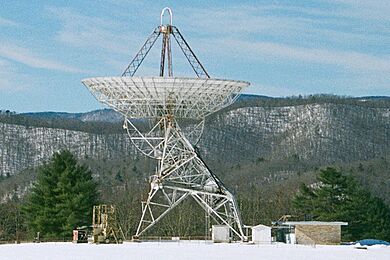
Howard E. Tatel Radio Telescope (85-1), the first element of Green Bank Interferometer
|
|
| Location(s) | Green Bank, Pocahontas County, West Virginia |
|---|---|
| Coordinates | 38°25′58″N 79°50′22″W / 38.4328°N 79.8394°W |
| |
|
The Green Bank Interferometer (GBI) was a special kind of radio telescope located in Green Bank, West Virginia, in the United States. It was run by the National Radio Astronomy Observatory. Unlike a single telescope, an interferometer uses several telescopes working together. This setup helps scientists get much clearer images of things far away in space.
The GBI used three large radio telescopes, each 85 feet (26 meters) wide. These were called 85-1, 85-3, and 85-2. Telescope 85-1 was also known as the Tatel Telescope. The GBI also used a smaller, portable telescope that could be moved to different locations.
Contents
How the Green Bank Interferometer Worked
An interferometer combines signals from multiple telescopes. Imagine trying to see a tiny object very far away. One telescope might see it as a blurry dot. But if you have two or more telescopes spread out, they can work together. They act like one giant telescope, giving a much sharper view. This technique is called aperture synthesis.
The GBI used this method to study radio waves coming from space. These waves tell us about distant stars, galaxies, and other cosmic objects.
Building the First Telescopes
The first telescope, 85-1 (Tatel), was built in 1959. It stayed in one spot. In 1960, it was used for an important project called Project Ozma. This project was one of the first attempts to listen for radio signals from intelligent life in space.
In 1963, plans were made to add more telescopes to create an interferometer. A second 85-foot telescope, 85-2, was built. It was finished in 1964. A track about 1.5 miles (2.4 km) long was built from 85-1. Telescope 85-2 could move along this track. Cables connected the two telescopes so they could work together.
Expanding the Array
The GBI started working as a two-telescope interferometer in 1964. Its main goals were to test how large telescope arrays could work and to study radio astrometry. Astrometry is the science of measuring the positions and movements of stars and other celestial bodies. Scientists also studied interstellar scintillation, which is like the twinkling of stars, but for radio waves.
In 1967, a third telescope, 85-3, was added. It was placed in the middle of the track. Both 85-2 and 85-3 had special truck tires. These tires allowed them to be moved along the track. This helped scientists test different distances between the telescopes.
Adding Portable Telescopes
Scientists soon realized that having a longer distance between telescopes would give even better results. So, a smaller, portable 42-foot (13-meter) telescope was brought in. This telescope could be moved far away from the main Green Bank site. It was placed 8 miles (13 km) away, then 11 miles (18 km), and finally 26 miles (42 km) away. This created a "T" shape with the other telescopes. This setup was similar to the design of the much larger Karl G. Jansky Very Large Array (VLA).
In 1973, the 42-foot portable telescope was replaced with a 45-foot (14-meter) portable telescope. This new telescope was used until 1983.
Later Operations and Closure
From 1978 to 1996, the GBI helped with important programs for the U.S. Navy. These programs focused on measuring Earth's shape and studying astronomy. In 1983, the 45-foot portable telescope was moved back to Green Bank. It was then used to track Space VLBI satellites. A new 46-foot (14-meter) portable telescope took its place for interferometer work until 1988.
In 1988, the GBI changed back to a two-telescope system. Telescope 85-3 was then used for other tasks, like monitoring pulsars. Pulsars are rapidly spinning neutron stars that send out beams of radio waves.
The GBI started working again on November 22, 1996. This time, it was used to monitor sudden changes in space. It looked for things like X-ray binaries (star systems that produce X-rays), active galaxies, and gamma-ray sources. These are all powerful events in the universe.
Some of the cosmic objects the GBI monitored included GRS 1915+105, GRO J1655-40, Cyg X-3, and Cyg X-1.
Sadly, the GBI monitoring program stopped on October 6, 2000. This happened because there was no longer enough money to keep it running.
Technical Details of the GBI
When the GBI operated as a two-telescope interferometer, it had some impressive technical features:
- Baseline: The distance between the two main telescopes was 2,400 meters (about 1.5 miles).
- Bands: It could "listen" to radio waves at two main frequencies: 8.3 GHz (called X-band) and 2.25 GHz (called S-band).
- Receivers: The equipment that picked up the radio waves was kept super cold. This helped them detect very faint signals from space.
- Sensitivity: The GBI was very sensitive. It could detect weak signals, helping scientists find distant and dim objects.
- Resolution: The GBI could see very fine details in space. At X-band, it could resolve objects as small as 3 arcseconds. An arcsecond is a tiny fraction of a degree, showing how precise the GBI was.
See also
- List of radio telescopes


